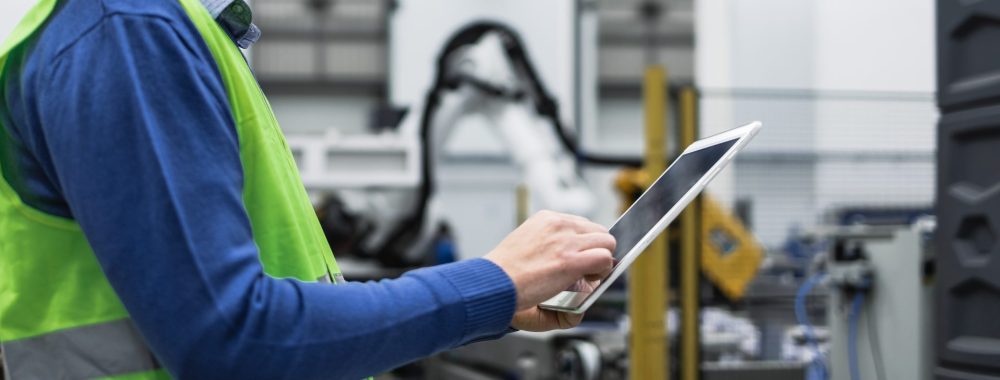Manufacturing technologies provide an unprecedented transformation for business profitability and competitiveness. Among the technologies that have recently transformed manufacturing are Big Data, IoT, 3D printing and Artificial Intelligence.
However, the evolution of these is increasingly rapid and new ways to multiply productivity and profits of production plants are emerging.
We tell you 4 technological trends that will revolutionise the scenario of industrial production in 2020:
1. Robotic Process Automation (RPA)
What is it?
This technology, increasingly transformative, allows anyone to configure a computer software that makes it possible for a “robot” to emulate and integrate the actions of human interaction in digital systems to run an industrial or commercial process.
The RPA acts as a disruptive and sophisticated system that takes the traditional ERP system to another level, providing it with machine learning to make the most of the automation it enables.
What will it be used for?
RPA allows automation at a fraction of the cost and time previously spent. Furthermore, this technology is non-intrusive in nature and leverages existing infrastructure without disrupting the underlying systems, which would be very complex and costly to replace.
RPA multiplies the efficiency of any high-volume, business rule-driven, repeatable process. An order list is generated automatically and executed by a software robot, freeing employees to concentrate on tasks that bring real value to the company.
Benefits
- Instant and significant cost reduction: robots perform repetitive tasks much more efficiently than humans. When work is automated, it is not only completed faster, but can also be performed 24 hours a day at a much higher rate, without making mistakes, and at a much lower cost than employees.
- Quick realisation of benefits: it requires a low initial investment, but in the short term results can be seen as a significant improvement in the quality of certain processes, which will be projected in the profitability of the company.
- Improved cycle time: this sophisticated automation system will save time to all parts of the company and avoid disruption of underlying systems. Companies will not have to outsource parts of the labor-intensive work to third parties, so they will have more and better control of their operations while reducing risk.
- Highly scalable and flexible system: it adapts to the changing business environment, helping business leaders to make better decisions for the future in different scenarios. In addition, automation through RPA does not require coding or scripting so transferring processes from human to machine will not be a problem.
2. Distributed Cloud Computing
What is it?
The distributed cloud is the future of the cloud and the evolution of Cloud Computing. It is a multi-cloud concept with a geographically dispersed infrastructure that mainly runs services at the edge of the web.
While services are distributed to different physical locations, they are centrally managed and operation, governance and evolution remain the responsibility of the public cloud provider.
This type of cloud represents the coming together of several clouds that combine their different capabilities, so enterprises can draw on a combination of locations and cloud environments that best meets their requirements for performance, regulatory compliance and more.
What is it used for?
The pandemic has greatly reinforced the need for organisational ecosystems to be able to function remotely. The location independence it has generated requires a technology shift that can support this new version of business.
The speed of these changes does not yet allow for sufficient agility and functionality, either at the practical level or at the level of legal regulations. For this reason a growing trend is the use of hybrid and multi-cloud implementations.
This model allows for the distribution of a public cloud provider’s entire compute stack to wherever a customer may need it: on-premise, in the customer’s own data center, in the private cloud, or off-premise. This model provides an agile environment for low-latency organisational scenarios and allows servers and applications to run closer to where data is created.
Benefits
- Improves visibility and manageability of the hybrid or multi-cloud: Any organisation gains greater control over its multi-cloud infrastructure by providing visibility and centralised management, resulting in improved production processes.
- Ensures scalability and agility: Expanding or building data center locations is expensive and time-consuming. With the distributed cloud, an organisation can expand its existing infrastructure or edge locations without physical construction.
- Data security and on-premise compliance: Distributed cloud infrastructure makes it much easier for an organisation to process personal information (PI) in each user’s home country and therefore comply with data privacy regulations.
- Offers Repeatability and Reliability: Geographic replication promotes cost reduction and critically lowers latency. By dynamically hosting information, companies can combine the capabilities of different locations and reduce the risk of global network disruptions.
3. Augmented Analytics
What is it?
Augmented analytics combines natural and narrative language technologies, augmented data preparation, advanced automated analysis, and visual data discovery capabilities to improve workflow.
It is the idea of leveraging technologies such as machine learning and analysis to help automate the entire data management process, from data preparation to knowledge generation and support for model building and implementation.
What will it be used for?
It enhances the way people explore and analyse data on analysis platforms. By automating many aspects of data science, it democratizes access to advanced analytics and drives data management. It aims to automate data collection and preparation processes to save data scientists and organisations a great deal of time and money.
Benefits
- They democratize data science to the entire organisation: they make the process of data analysis simple and accessible for many of an organisation’s profiles. Any user with a minimum of knowledge about how it works and what it contributes, will be able to obtain valuable relationships and conclusions.
- Improved data literacy: with natural language that helps explain findings and provides automated analysis of results, your users can improve their data literacy. In addition, it allows you to have dashboards in an automatic and understandable way, as well as descriptive and predictive approaches, and SQL language is no longer necessary.
- Reduced Analytical Bias: Allowing the machine to perform analysis can help reduce analytical bias. If you do not know what you are looking for, you make assumptions trying to find it. Often, those assumptions could lead to the use of specific data to support it. Predictions become more accurate in terms of machine behavior, accounts, consumption patterns, etc.
4. 5G Network
What is it?
The name 5G refers to the fifth generation of mobile networks that we know. The most significant advance has to do with speed. 5G will allow navigation at up to 10 GBs (gigabytes per second), 10 times faster than the main optical fiber offers in the market. The other advance has to do with latency (the network response time) which could be reduced to 5 milliseconds, which will allow connection practically in real time.
What will it be used for?
This new network will be transformative for devices that drive automated industrial processes. Its high reliability and low latency will feed the sensors in industrial machines more efficiently than ever before.
The high bandwidth and connection density ensure ubiquitous connectivity. For these reasons, it will help generate a large amount of data that will open new avenues for cost savings and efficiency when combined with machine learning.
Main benefits
- You will connect more devices significantly faster: by enabling a massive volume of data transmission from a large number of more responsive devices, much more valuable information can be captured.
- Enable near-real-time data transmission: By immensely reducing latency levels to less than 10 milliseconds, delay time between devices is greatly reduced and data is captured in near-real time.
- Prevents data loss and boosts productivity: Ensures connections are ultra-reliable and secure to prevent data loss and maximise production performance, without sacrificing flexibility, traceability, sustainability or security.
- More flexibility with wireless factories: Operators can power all their facilities, on and off-site, seamlessly with a network for near-wireless operations and faster adoption of new technologies.
2021 Trends
As businesses face the economic consequences and difficulties caused by the COVID-19 pandemic, organisational leaders continue to be challenged to achieve effective human-technology interaction. On the other hand, industrial companies increasingly need technologies to support them, making them stronger and more resilient in the face of future instability.
Nexus Integra is the integrated operations platform that will help you become a smart factory and guide you in the process of acquiring and internalising new technologies to get the most out of them.
Do you want to know more about how to implement Nexus Integra and what benefits it would bring to your company? Contact us to study your case and receive personalised assistance.


